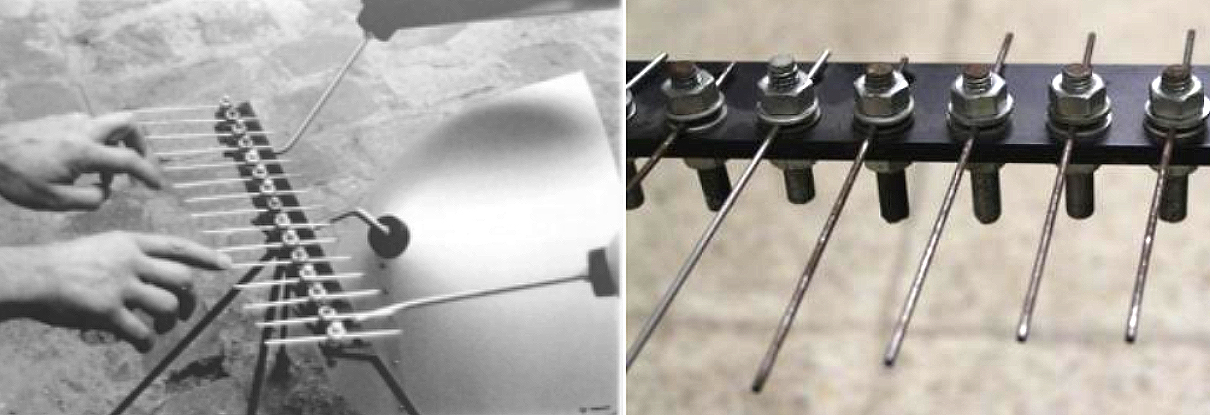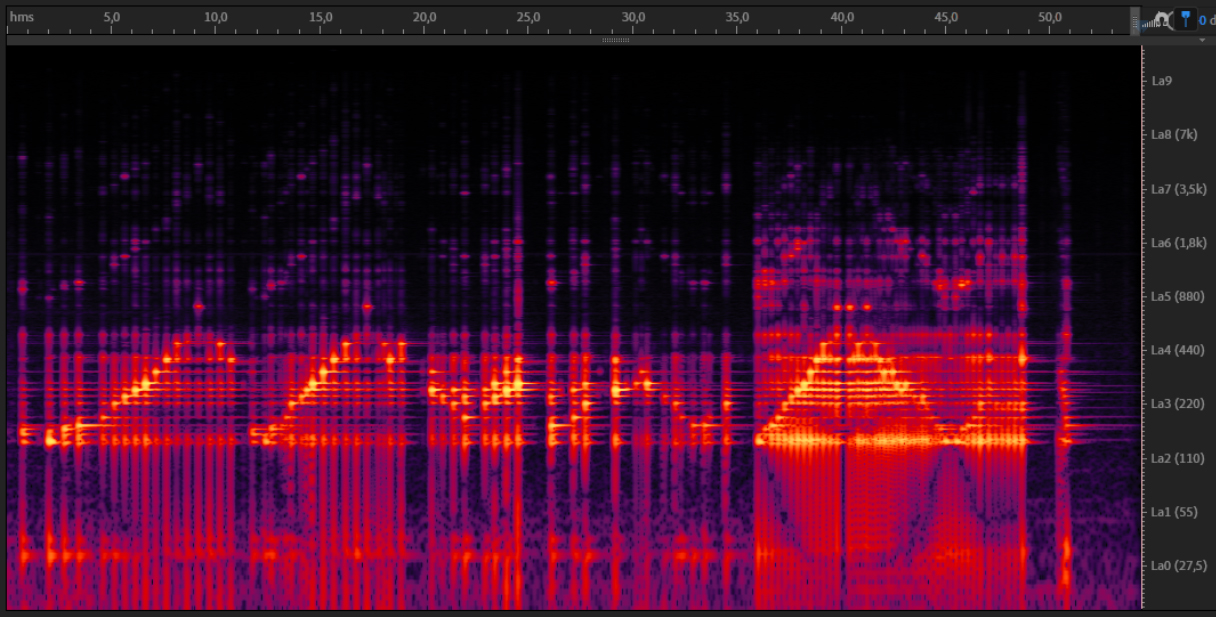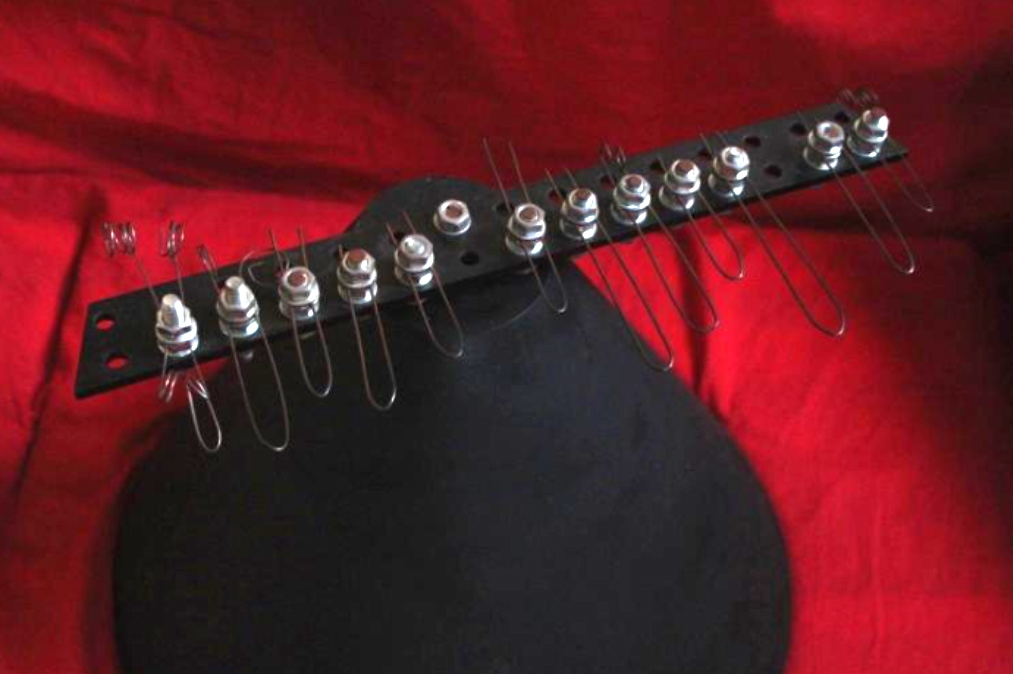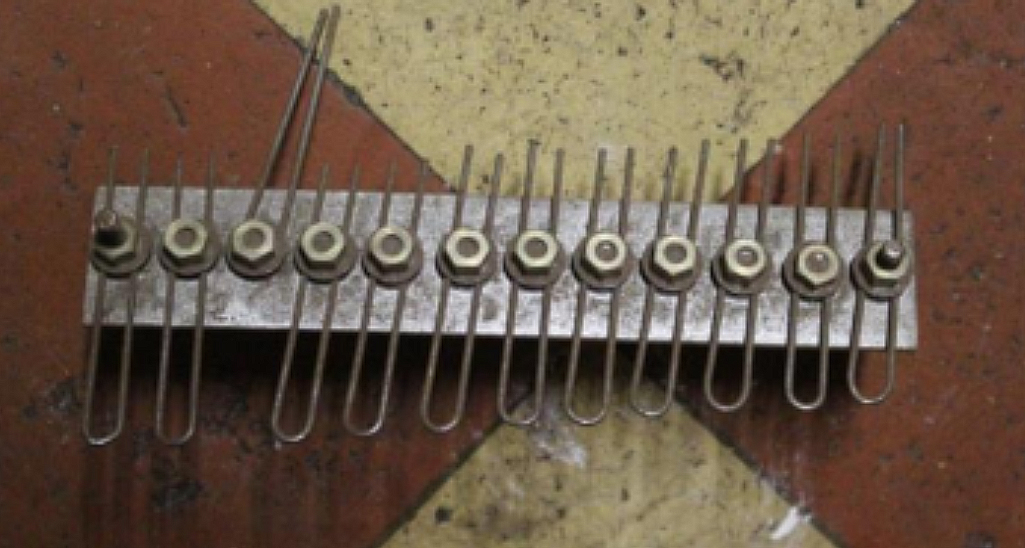We have presented this après-Baschet kit set because we did not have audio of the original Baschet pieces with this mounting system, although we have seen them first-hand at the former Baschet workshop in Paris, as shown in the picture (on the right), unfortunately out of context, detached from any radiating element.
For the Osaka Universal Expo in 1970, François Baschet made a huge thumb piano by connecting a relatively small steel gum with about a dozen wire D-shaped tongues to a big metal radiator (pictured to the right). It was not included within the initial program for the Expo’70, and we haven’t found recordings, but it would be easy to rebuild. This mounting system might be the most obvious connection between clamped rods and thumb pianos, demonstrating the relationship between all odontophones as we understand it.
Clamped Piano Wire
Piano wire is a common denomination for tempered spring steel wire, which is more elastic than the other steel rods or plates we have discussed here. It is available in varying thicknesses, from as thin as a violin string (0.5-2mm) to as thick as a stiff rod (2-10mm). The Baschet Brothers used piano wire to create straight whiskers, spirals, and coiled resonating elements, as well as applying it as a special material for their clamped oscillators. They most often used piano wire in short sections (2-10cm) to be plucked, as in thumb pianos, and in longer sections (10-50cm) for keyed piano-like devices.
Baschet Piano, in collaboration with Pierre Malbos, circa 1990
Oscillators: 31 straight tempered steel piano wires, approximately 1mm in diameter, clamped in a sandwich gum (formed by two steel bars) attached to the wooden frame of the piano mechanism (not particularly isolated or suspended as most odontophones are).
Activation: a repurposed piano action mechanism (keys, dampers, hammers, etc.)
Radiation: five thick cardboard cones, one stainless steel cone, and one bent stainless steel sheet.
Gamut: chromatic (12-TET) “inharmonically harmonized” due of the resonance interaction of the rods’ overtones.
Resonators: the complex rod system creates a particular resonating system that has an impact on the sonority of each rod, specifically the perceived pitch (or cluster of pitches). The stainless radiator also adds reverberation and some degree of overdriven dynamic response when played forte.
The Baschet Piano is a great example of the new tunings we can obtain by exploring inharmonic oscillators: chromatically tuned, but producing a sound closer to other odontophones and distant from a conventional piano.
Despite the medium size of this piece, the rods are set in a length too long for their fundamental mode to be audible (that wavelength is subsonic), so what we hear from each rod are the higher partials with strange inharmonic ratios. The lower, and usually most prominent, overtone of each rod has been chosen as the root tone for each rod, and has been tuned a 12-TET by shortening the length of each rod. This is done with notable accuracy, considering the difficulties of tuning a particular order of overtones amongst the clusters of overtones that every rod in the system produces. The second octave of the keyboard follows this progression and already shows the presence of lower tones appearing below the tuned pitch due to the shortening of the rods belonging to the next vibrational mode.
As we can see in the spectrogram, each rod produces many overtones. These rods are probably the thinnest and proportionally longest of all the examples presented. Rods that long always produce many overtones and, depending on the register, we might not hear some of them. However – a result of the connection of all the rods to the same gum and the process of tuning – the most prominent low frequency chromatically creates a system of reharmonization in which every rod produces a perceptible cluster of tones, mostly major 6ths and major 9ths, above the tuned root tone.
Since we don’t know exactly which overtone we are hearing as a root tone for a specific set of rods, it would be hard for us to say which are the natural ratios of the overtones of a single rod set in any of these lengths. Anyway, our intuition and experience with such complex configurations prompts us to think that there are subtle overtone retunings occurring naturally due to the resonance amongst all the rods, producing more consonant intervals than the ones we would get if the rods were tuned randomly.
When someone plays on this piano, melodic lines can be followed, but there is a strange sense of a chromatic piano keyboard reharmonized through a warm set of chimes. The goal here is to invite listeners to explore sound in a new way rather than reproducing what we already are familiar with. If someone plays a known tune, it will be reharmonized, pulling them to the reality of this unique sonority; chords and harmonies become something new again, and the whole thing blooms when we play while paying much more attention to what we hear than to any musically-educated intentions.
Plucked thumb pianos
The Baschet explored the use of piano wire for finger-plucked kalimbas in two clamped oscillator configurations: straight short segments and bent “D” shapes. The D shape mimics the contour of the lamellae of kalimbas, offering a soft rounded area at the free end to be plucked, which is much more comfortable to the touch than the sharp end of a wire.
Kit Zanza, circa 1980
Oscillators: 15 short straight segments of piano wire, clamped to a gum from a DIY kit.
Activation: plucking (percussion is also possible: in the second half of the recording we used a tiny mallet because plucking with fingers is not really that comfortable).
Radiation: 3 cardboard cones (in the recording we only used one).
Gamut: with these short lengths of wire we hear the fundamental pitches of each wire (thin rod). The first inharmonic overtone is quite distinguishable, especially in the longer lower pitched wires. The gamut found in this original kit is quite random, just a row of tones from low to high, left to right. The system allows for easy retuning, since it is just a matter of loosening the nut, sliding the wire, and re-tightening the nut to check the pitch. Most likely this was tuned and re-tuned in several different ways.
DIY D-Thumb Piano kit, après-Baschet, by Martí Ruiz, 2013
Oscillators: 12 D-shaped piano wires, 1mm in diameter, each clamped between a pair of nuts on a bolt connected to an original Baschet DIY kit steel gum through pre-drilled holes. Some of the leftover/excess of the wire coming from the other side of the nuts seemed useful, so we bent them into spirals. One of the D shapes was formed into a loop, creating a distinctive, lower sound.
Activation: flinger plucking and scraping with chopsticks.
Radiation: hard cardboard cone with fiberglass resin.
Gamut: we implemented a scale following our intuition, playing to build the sound, not following any preconceived idea or order. The whole gamut grew from the sense of mystery that we found in bending the excess of the wires into spirals. The sound of these modified wires gave us the motivation for the gamut (overall sound).We can hear the timbre of the D-shaped wires as distinctive from the wires with spirals and the single surplus wires. Using a chopstick produces a brighter sound, with less presence of the fundamental frequencies. In contrast, plucking the D-shapes produce a fuller sound.
Figure 42. Audio recording and spectrogram of the DIY D-Thumb Piano kit. (Ruiz 2015).
At the end of this file, we hear the rattling of the excess wire spirals with the chopstick, creating tiny high-pitched sounds, a bit like water drops.
Figure 36. Video of Baschet Piano. Source: https://www.youtube.com/watch?v=_D2-yOshcec&t=20s






